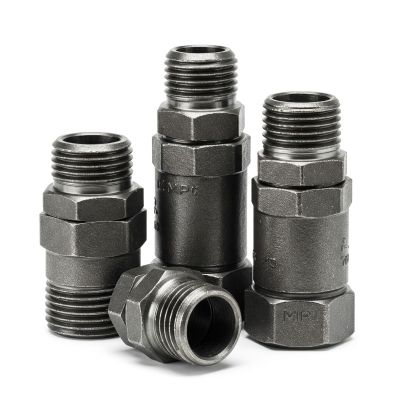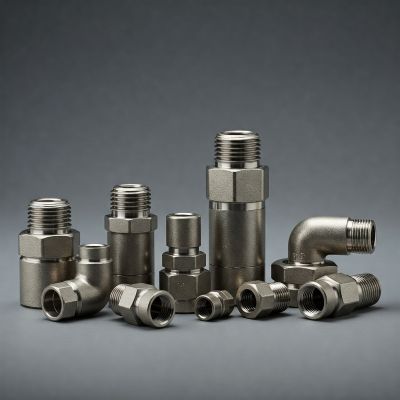MIP (Male Iron Pipe) and NPT (National Pipe Thread) are two common types of threaded fittings used in plumbing and piping systems. Understanding thread compatibility is crucial to ensuring leak-free and secure connections.
While these terms are often used interchangeably, it is essential to know whether they are truly the same and how they relate to one another. This article will clarify the differences between MIP and NPT and their compatibility in various applications.
What Is MIP?
MIP, or Male Iron Pipe, refers to externally threaded pipe fittings designed to connect with corresponding female-threaded fittings. These fittings are widely used in plumbing and industrial applications for water, gas, and air systems.
Common Uses of MIP Fittings:
➡️ Residential and commercial water supply systems
➡️ Gas lines for heating and cooking
➡️ Industrial applications requiring high-pressure connections
Typical Materials:
MIP fittings are made from various materials, including:
➡️ Brass
➡️ Galvanized steel
➡️ PVC
➡️ Stainless steel
What Is NPT?
NPT, or National Pipe Thread, is a standard for threaded pipe connections in the United States. NPT threads are designed with a tapered profile, which allows for a tighter and more secure connection when sealed properly.
Key Features of NPT Threads:
➡️ Tapered Design: The threads gradually decrease in diameter, creating a mechanical seal when tightened.
➡️ Sealing Mechanism: Requires thread sealant, such as Teflon tape or pipe dope, to prevent leaks.
Common Applications of NPT Threads:
➡️ Plumbing systems (water and gas lines)
➡️ Hydraulic and pneumatic systems
➡️ Industrial piping networks
MIP vs. NPT: Key Differences
Although MIP and NPT threads are often associated with each other, they have distinct characteristics that set them apart.
1. Thread Design: Tapered vs. Straight Threads
➡️ NPT threads are always tapered, which allows for a more secure seal as they tighten.
➡️ MIP threads are often considered equivalent to NPT, as MIP fittings also have a tapered design.
2. Compatibility: Can MIP and NPT Threads Fit Together?
➡️ In most cases, MIP fittings are compatible with NPT fittings since both share the same thread profile and taper angle.
➡️ Proper sealing with Teflon tape or pipe dope is required to ensure a leak-free connection.
3. Common Applications: Differences in Use Cases
➡️ MIP is a term commonly used in plumbing hardware stores, whereas NPT is the official thread standard.
➡️ Both types are used in water and gas lines, but industrial specifications typically refer to NPT.
4. Markings & Identification: How to Tell Them Apart
➡️ MIP fittings are often labeled as “MIP” on packaging, whereas NPT fittings may simply be marked “NPT” or “Pipe Thread.”
➡️ Checking the manufacturer’s specifications is the best way to confirm the thread type.
Are MIP and NPT Interchangeable?
While MIP and NPT fittings are functionally similar and generally compatible, it is essential to follow best practices to ensure a proper fit and avoid potential issues.
Using Proper Sealing Materials
➡️ Always apply Teflon tape or pipe dope to male threads before connecting.
➡️ This helps create a watertight and airtight seal, preventing leaks.
Potential Risks of Incorrect Pairing
➡️ Leaks: Improper sealing or over-tightening can result in leaks.
➡️ Thread Damage: Forcing mismatched threads can cause stripping or deformation.
➡️ Pressure Failures: Incorrectly paired fittings may not withstand high-pressure systems.
Best Practices for Thread Compatibility
Ensuring a secure and leak-free connection involves selecting the correct fittings and following proper installation techniques.
How to Determine the Correct Fitting for Your Application
➡️ Verify the thread type by checking manufacturer specifications.
➡️ Use a thread gauge to confirm compatibility if unsure.
Proper Installation Techniques
➡️ Wrap male threads with 2-3 layers of Teflon tape before tightening.
➡️ Hand-tighten the fitting first, then use a wrench for additional tightening (without over-tightening).
➡️ Inspect for leaks after installation and reapply thread sealant if needed.
Common Mistakes to Avoid
➡️ Using excessive force can damage the threads.
➡️ Not using thread sealant leading to leaks.
➡️ Mismatching threads between different pipe standards (e.g., mixing BSPT with NPT).
Conclusion
MIP and NPT threads are closely related, with MIP fittings generally being compatible with NPT threads due to their similar taper design. However, it is crucial to use proper sealing techniques and verify compatibility before installation.
Selecting the correct fitting ensures safe, secure, and leak-free connections in plumbing and industrial applications. Always check manufacturer specifications and follow best practices to avoid common threading issues.
Post time: Mar-11-2025



